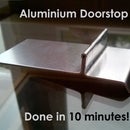Introduction: How to Make a Soldering Aid / Helping Hand.
This instructable will tell you how to make a helping hand, or soldering aid. A soldering aid is a really useful device to help hold parts that you are soldering. My version also provides a space for a sponge, to clean your soldering iron, and a space for a tube of solder. It is a low effort, no cost project as it can be made with scraps you find around the house. Mine took me about 30 minutes to make, bearing in mind that I had to come up with the ideas myself and I didn't have this instructable! It is very sturdy and has put up with 2 years of being dropped, burned and bashed so far.
You will need:
A scrap of wood (5cm x 7 cm x 12cm is about right)
At least 2 clothes line pegs (wooden is better)
Sponge
Wood saw
Drill (about 20mm diameter) with long shaft
Chisel
Small Hammer
Paint (optional)
Loud Rock Music (optional)
I'm assuming that you know how to use the tools, so let's get started!
Step 1: Making the Base.
The base part is very simple, just cut the wood to size (you can decide the size yourself, mine is 140mm long, 70mm high and 45mm deep). Then take a chunk out of one end to make the sponge holder. I suggest losing about half the overall height and 1/3 of the length. To make the recess for the sponge, use the chisel to go down about 10mm, leaving a 5-10mm border around the edges (see picture).I also cut a channel in the end to let excess water from the sponge drain out, rather than into the wooden base. The paint is there to provide some rudimentary waterproofing for the same reason (it is acrylic-based paint, and has worked remarkably well; it has lasted 2 years so far with no signs of rot). If painting it, do not paint the parts in close contact with the soldering iron, as the paint could give off harmful fumes when hot (also leave plenty of time for it to dry; this is where the loud music comes in handy). The last task here is to make the hole for the tube of solder (see picture). This is just drilling a 100mm hole in the side of the base. Make sure not to angle the drill here and don't drill too close to the edge of the wood. If you use reels of solder, you could add a small length of wooden dowel in place of the hole. This would allow you to hold the reel and the reel to turn as you used the solder.
Step 2: Adding the Pegs.
This is also very easy, just take apart the pegs and nail one half on. Use very thin nails to avoid splitting the pegs. Do not use plastic pegs as they melt when you're soldering stuff. Then just put the spring and other half of the pegs back on and you're ready to go!
I would consider the distance apart that you put the pegs. For me, I do a lot of model electronics involving small parts so I needed the pegs fairly close together. If you do bigger stuff, then make the pegs further apart (or use more pegs!).
Thanks for reading and please leave your comments!













